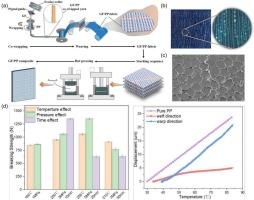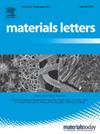Performance evaluation of glass fiber reinforced thermoplastic composites prepared via the co-wrapping method
IF 2.7
4区 材料科学
Q3 MATERIALS SCIENCE, MULTIDISCIPLINARY
引用次数: 0
Abstract
The trend towards lightweighting in new energy vehicles is increasingly focusing on substituting steel with plastics. Achieving cost-effective, highly infiltrated thermoplastic composites is pivotal. This research employs the co-wrapping method to fabricate glass fiber/polypropylene (GF/PP) yarns, and integrates weaving with compression molding for GF/PP composite preparation. Results indicate that optimized co-wrapping parameters and structure effectively minimize glass fiber damage and enhance yarn mechanical properties, particularly with the double-wrapped PP yarn (GF/DPP). Under conditions of 5 MPa, 205 °C, and 10 min, GF/DPP composites achieve the highest tensile fracture strength (1350 N). The co-wrapped GF/DPP yarn not only achieves excellent infiltration, but also significantly reducing the thermoplastic composite preparation time. This advancement could open new avenues for the lightweight structural design and manufacturing of thermoplastic composites.

通过共包法制备的玻璃纤维增强热塑性复合材料的性能评估
新能源汽车轻量化的趋势越来越注重以塑料代替钢材。实现高性价比、高浸润性的热塑性复合材料至关重要。本研究采用共包法制造玻璃纤维/聚丙烯(GF/PP)纱,并将编织与压缩成型相结合,制备 GF/PP 复合材料。结果表明,优化的共包覆参数和结构可有效减少玻璃纤维的损伤,提高纱线的机械性能,尤其是双层包覆的聚丙烯纱线(GF/DPP)。在 5 兆帕、205 °C 和 10 分钟的条件下,GF/DPP 复合材料达到了最高的拉伸断裂强度(1350 牛顿)。共包 GF/DPP 纱线不仅实现了出色的浸润效果,还大大缩短了热塑性复合材料的制备时间。这一进步可为热塑性复合材料的轻质结构设计和制造开辟新的途径。
本文章由计算机程序翻译,如有差异,请以英文原文为准。
求助全文
约1分钟内获得全文
求助全文
来源期刊

Materials Letters
工程技术-材料科学:综合
CiteScore
5.60
自引率
3.30%
发文量
1948
审稿时长
50 days
期刊介绍:
Materials Letters has an open access mirror journal Materials Letters: X, sharing the same aims and scope, editorial team, submission system and rigorous peer review.
Materials Letters is dedicated to publishing novel, cutting edge reports of broad interest to the materials community. The journal provides a forum for materials scientists and engineers, physicists, and chemists to rapidly communicate on the most important topics in the field of materials.
Contributions include, but are not limited to, a variety of topics such as:
• Materials - Metals and alloys, amorphous solids, ceramics, composites, polymers, semiconductors
• Applications - Structural, opto-electronic, magnetic, medical, MEMS, sensors, smart
• Characterization - Analytical, microscopy, scanning probes, nanoscopic, optical, electrical, magnetic, acoustic, spectroscopic, diffraction
• Novel Materials - Micro and nanostructures (nanowires, nanotubes, nanoparticles), nanocomposites, thin films, superlattices, quantum dots.
• Processing - Crystal growth, thin film processing, sol-gel processing, mechanical processing, assembly, nanocrystalline processing.
• Properties - Mechanical, magnetic, optical, electrical, ferroelectric, thermal, interfacial, transport, thermodynamic
• Synthesis - Quenching, solid state, solidification, solution synthesis, vapor deposition, high pressure, explosive
 求助内容:
求助内容: 应助结果提醒方式:
应助结果提醒方式:


